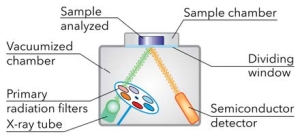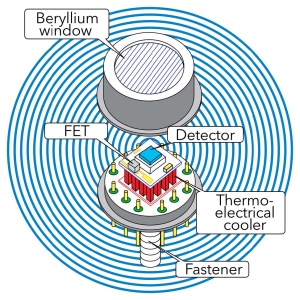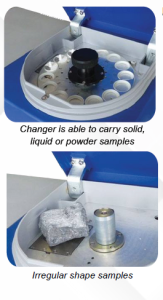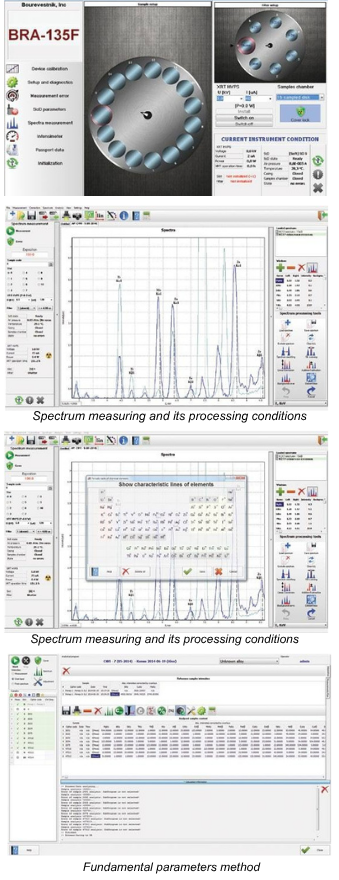Description

X-ray fluorescence energy dispersive general purpose spectrometer BRA-135F allows simultaneous determination of chemical elements by characteristic energies in the 1 to 30 keV range (where elements from F till U are fitted) over a wide scope of concentrations from hundreds ppb. BRA-135F analyzes solid, powder and liquid samples, thin layer on the surface or precipitated on filters.
Operating principle
The spectrometer operating principle is based on excitation of fluorescence radiation of atoms in the substance being analyzed by radiation coming from the low-power X-ray tube. The fluorescence radiation from the sample gets into the SDD semiconductor detector where quanta of different energies are converted into electrical pulses, which amplitudes are proportional to the energy of absorbed quanta. Pulse-frequency rate with the certain amplitude is proportional to the chemical element concentration in the sample.
Method advantages
X-ray fluorescence analysis (XRF) occupies a leading position among the other methods for determination of the quantitative elemental composition of substances. XRF advantages are as follows: nondestructive measurements, multielement determination, express method, high accuracy of analysis, wide range of measured concentrations, development level of quantitative analysis theory, possibility for quantitative analysis with absence of standard samples.
High efficiency SDD detector
The silicon drift detector (SDD) with ultra- thin entrance window allows to register x-ray radiation in wide energy range on re- tention of energy resolution and response.

Low detection limit
Owing to optimally selected materials and thickness of primary radiation filters, high transparent X-ray optical scheme, a low detection limit can be achieved for all elements to be analyzed. In the range of light elements from 9F to 17CI low-energy radiation registration becomes possible using vacuum where the optical path of radiation passes.
Large or irregular shape samples
It is possible to measure large-size or odd-shaped samples:
- Large-size minerals and nuggets;
- Industrial articles for analysis for ROHS requirements;
- Metals and alloys incoming control;
- Analysis of liquids in the special cells or on the special filters.
Compact body and functionality
- The housing spectrometer ensure fully radiation-protection;
- Handles for carrying;
- Built-in operational computer (PC);
- LAN port for remote control and archiving of measurement results
- LIMS integration is available;
- Easy report creation;
- Password protection and separation of access rights

Fields of application

| Technical Sheet | |
| Range of detected elements | F – U |
|
Limits of detection without preliminary enrichments, %
|
n*10 0.002 0.0005 |
| Limit of determination at sample preconcentration (depending on chemical element), % | 1.5 10 |
| Limit of determination in mid group element (liquid), g/dm | n 10 |
| Average time of one sample analysis, s | 100 |
| Energy resolution on MnKa line at pulses counting rate up to 10 s , not more than, eV | 145 |
| Max. voltage of X-ray tube, kV | 50 |
| X-ray power, W | 10 |
| X-ray tube cooling | by air |
| Primary X-ray radiation filters, pcs | 5 |
|
Number of samples installed into sample changer, up to hanger #1 (Ø34 mm samples) changer #2 (Ø34,36,40,44 mm samples) |
15 11 |
| Maximum sample size, mm | Ø200 x 60 |
| Ethernet connection | Yes |
| Possibility for remote control | Yes |
| Overall dimensions (LxHxB), mm | 700x410x400 |
| Instrument weight, max, kg | 65 |
| Power | 220 V, 50 Hz |
| Power consumption, W | 500 |
Methodology description
Oil analysis
For measuring purposes of trace elements Al, Ba, Ca, Cu, Fe, Mn, V, Ni, Pb, Zn, P into oil and petrochemicals appropriate methodology was developed.
Analytic complex consisting of BRA-135F and measuring methodology is capable of carrying out quantitative element analysis of petrochemicals in order to define metal trace elements and can be used to analyze exhausted motor oils of aircraft, machines, special motor vehicle in order to identify deterioration rate of engines and define applicability of technical service for it. Methodology is purchased additionally.
Besides BRA-135F could be used for testing as per ASTM D4294 and ASTM D6481. These test methods cover the measurement of sulfur, Barium, Calcium, Magnesium, Phosphorus, Zinc & Chlorine in hydrocarbons, such as lubricating used oil, diesel, naphtha, kerosene, residuals, lubricating base oils, hydraulic oils, grease, jet fuels, crude oils, gasoline (all unleaded), and other distillates. Additionally, sulfur in other products, such as M-85 and M-100, may be analyzed using this technique.
Detection limits of BRA-135F according to certified methodology (ppm):
| P | Al | Mn | Ba | Pb | V | Cu | Ni | Fe | Zn | Ca |
| 100 | 100 | 5 | 50 | 5 | 5 | 5 | 5 | 5 | 5 | 50 |
Cement materials analysis
For measuring purposes of mass fraction of Na, Mg, Al, Si, P, S, Cl, K, Ca, Ti, Cr, Mn, Fe, Zn, Rb, Sr into cements and cement production materials (clinkers, raw mixes) suitable methodology was developed.
Analysis methodology includes algorithms of principal components determination using X-ray energy dispersive fluorescent spectrometers BRA-135F and is based on recommendations from GOST 5382-91, GOST R 55410-2013 (ISO 12677:2011).
There is provided remelting method into platinum crucibles (according to GOST R 55410-2013) for samples preparation in the methodology.

Advanced software
BRA-135F software is the optimal combination of high performance and functionality with an intuitive interface and tooltips. Owing to this, performance of routine measurements requires no special trained staff.
Only few simple steps are enough to make a measurement: select the sample position, enter its code, choose the research method and run the analysis.
Excellent methodical support
Bourevestnik JSC has a methodological support of spectrometers, including the development and validation of methods for determining the elemental composition of various materials: oil products, ores, rock, slag, refining products, cement and raw mixes, soil and sediment, water, air.
Qualitative and quantitative analysis
BRA-135F software unveils wide opportunities for
on-line receiving of information on the chemical composition of the material to be analyzed. The user
chooses the method of substance analysis: qualitative or quantitative.
Registered spectra can be:
- saved in suitably structured archive;
- got out for repeat analysis based on a new calibration characteristics;
- processed as per user’s request: added, deducted, KLM-marked;
- scaled.
For operator convenience in operation, the auxiliary utilities were implemented to minimize errors during the analysis. For example, semi-automatic marker of lines allows correct identification of spectral lines of different elements.
Fundamental parameters method
The software implementing fundamental parameters method allows semi-quantitative and quantitative determination of elements within the range from Mg (12) to Pb (82) in solid samples of steels and alloys with composition of 0.1% to 100%.
If there are no standard composition samples, to calibrate the spectrometer and with large list of materials under analysis, the standardless semi-quantitative analysis is implemented, which represents the following dependences:
• integrated spectrometer sensitivity on Z element;
• relative (to the integral sensitivity) intensity of analytical line corrected for background and drift, on sample composition (this dependence was implemented through absorption parameter P).








